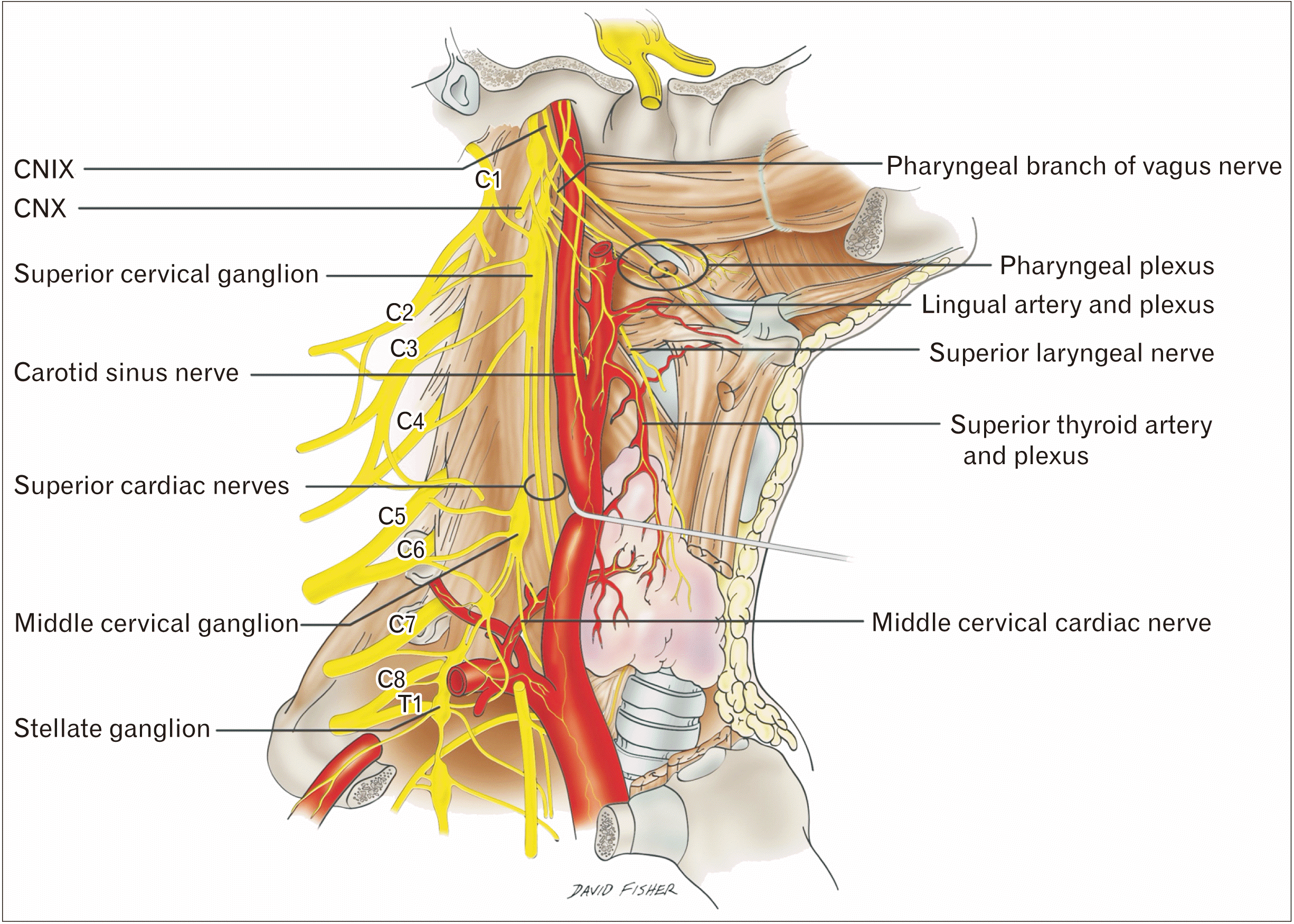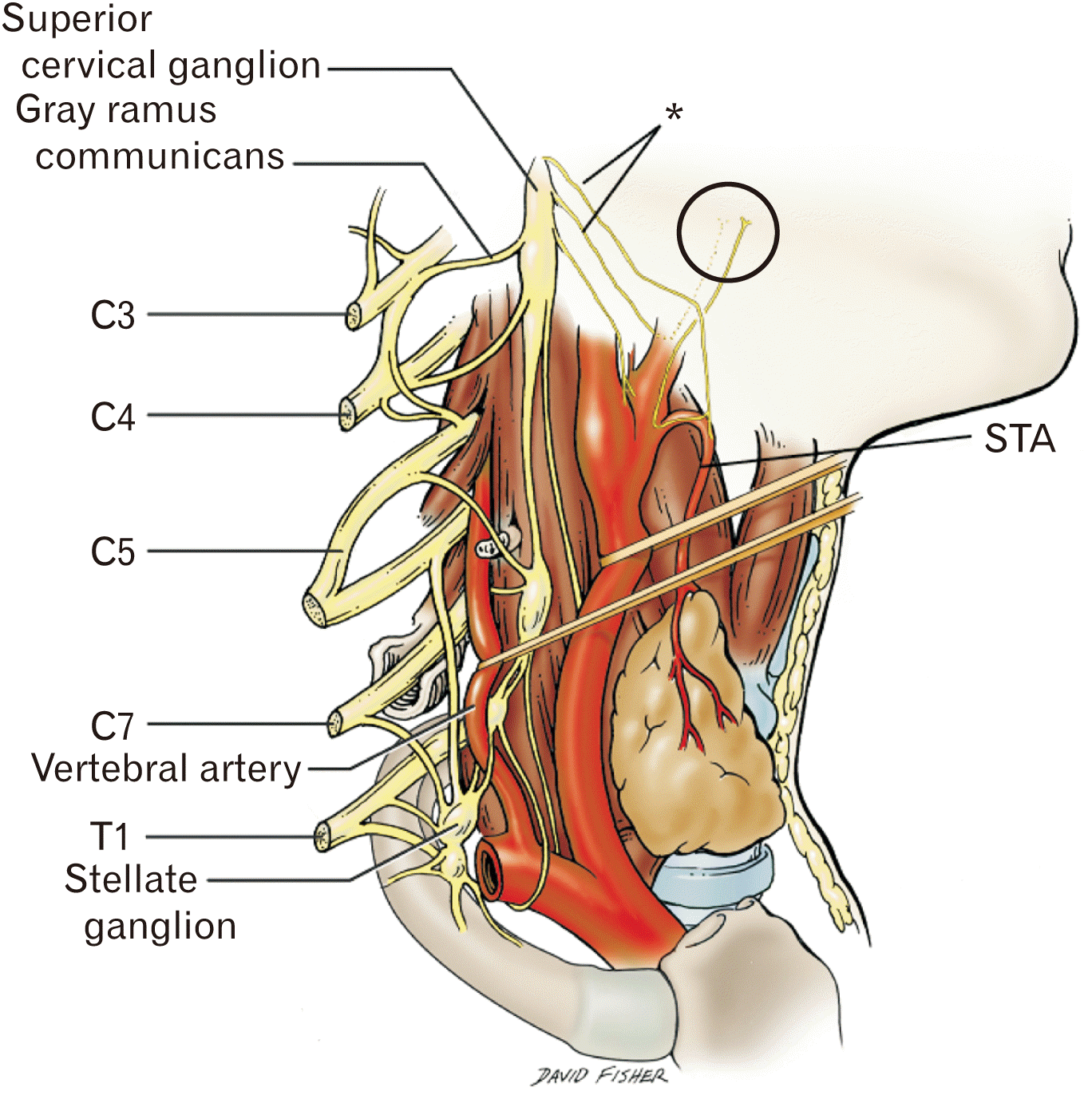3. Purnyn H, Rikhalsky O, Fedulova S, Veselovsky N. 2007; Transmission pathways in the rat superior cervical ganglion. Neurophysiology. 39:347–9. DOI:
10.1007/s11062-007-0053-2.

4. Mitsuoka K, Kikutani T, Sato I. 2016; Morphological relationship between the superior cervical ganglion and cervical nerves in Japanese cadaver donors. Brain Behav. 7:e00619. DOI:
10.1002/brb3.619. PMID:
28239529. PMCID:
PMC5318372.

5. Roesch ZK, Tadi P. 2020. Anatomy, head and neck, neck. StatPearls Publishing;Treasure Island:
6. Tubbs RS, Rizk E, Shoja MM, Loukas M, Barbaro N, Spinner RJ. 2015. Nerves and nerve injuries. Volume1: history, embryology, anatomy, imaging, and diagnosis. Elsevier;London:
7. Morris H, Anson BJ. 1966. Human anatomy: a complete systematic treatise. 12th ed. Blakiston Division, McGraw-Hill;New York: p. 1036.
8. Zubair A, Khan YS. 2021. Neuroanatomy, otic ganglion. StatPearls Publishing;Treasure Island:
9. Irwin PA, Tubbs RI, Tubbs RS. Tubbs RS, Shoja MM, Loukas M, editors. 2016. Autonomic nervous system. Bergman's Comprehensive Encyclopedia of Human Anatomic Variation. John Wiley & Sons;Hoboken: p. 1050–6. DOI:
10.1002/9781118430309.ch88. PMID:
27326756.

10. Arakawa T, Terashima T, Banneheka S, Tokita K, Fukazawa M, Suzuki R, Miyawaki M, Chiba S, Kumaki K, Miki A. 2008; Nerve communication between the glossopharyngeal nerve, external carotid plexus and the superficial cervical ansa: human autopsy case. Anat Sci Int. 83:112–9. DOI:
10.1111/j.1447-073X.2007.00183.x. PMID:
18507621.

11. Abe S, Fukuda M, Yamane S, Saka H, Katori Y, Rodríguez-Vázquez JF, Murakami G. 2013; Fetal anatomy of the upper pharyngeal muscles with special reference to the nerve supply: is it an enteric plexus or simply an intramuscular nerve? Anat Cell Biol. 46:141–8. DOI:
10.5115/acb.2013.46.2.141. PMID:
23869261. PMCID:
PMC3713278.

12. Shao BP, Ding YP, Xie ZH, Yu HX, Brand-Saberi B, Wang JL. 2007; The cranial cervical ganglion and its branches in the yak (Bos grunniens). Vet J. 173:174–7. DOI:
10.1016/j.tvjl.2005.08.016. PMID:
16246603.

13. Rusu MC, Pop F. 2010; The anatomy of the sympathetic pathway through the pterygopalatine fossa in humans. Ann Anat. 192:17–22. DOI:
10.1016/j.aanat.2009.10.003. PMID:
19939656.

14. Goudihalli SR, Goto T, Bohoun C, Nagahama A, Tanoue Y, Morisako H, Kawahara S, Ohata K. 2018; Sympathetic plexus schwannoma of carotid canal: 2 cases with surgical technique and review of literature. World Neurosurg. 118:63–8. DOI:
10.1016/j.wneu.2018.06.244. PMID:
30004012.

15. Salvesen R. 2001; Innervation of sweat glands in the forehead. A study in patients with Horner,s syndrome. J Neurol Sci. 183:39–42. DOI:
10.1016/S0022-510X(00)00479-2.

17. Fazliogullari Z, Kilic C, Karabulut AK, Yazar F. 2016; A morphometric analysis of the superior cervical ganglion and its surrounding structures. Surg Radiol Anat. 38:299–302. DOI:
10.1007/s00276-015-1551-3. PMID:
26364034.

20. Gertler JP, Cambria RP. 1987; The role of external carotid endarterectomy in the treatment of ipsilateral internal carotid occlusion: collective review. J Vasc Surg. 6:158–67. DOI:
10.1067/mva.1987.avs0060158. PMID:
3302317.

21. Michalinos A, Chatzimarkos M, Arkadopoulos N, Safioleas M, Troupis T. 2016; Anatomical considerations on surgical anatomy of the carotid bifurcation. Anat Res Int. 2016:6907472. DOI:
10.1155/2016/6907472. PMID:
27047690. PMCID:
PMC4800075.

22. Koziej M, Polak J, Wnuk J, Trybus M, Walocha J, Chrapusta A, Brzegowy P, Mizia E, Popiela T, Hołda M. 2019; The transverse facial artery anatomy: implications for plastic surgery procedures. PLoS One. 14:e0211974. DOI:
10.1371/journal.pone.0211974. PMID:
30730953. PMCID:
PMC6366864.







 PDF
PDF Citation
Citation Print
Print



 XML Download
XML Download